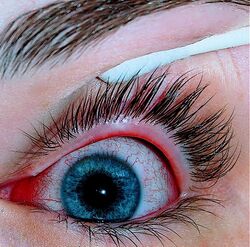Biology:Oculolinctus
Oculolinctus, also known as "worming" or eyeball-licking, refers to the paraphilic practice of licking eyeballs for erotic gratification. In mid-2013, English-language newspapers reported that this kink had allegedly become popular in Japan , where it was referred to as Gankyū name purei (眼球舐めプレイ, "eyeball licking play").[1] However, other media have reported that the existence of this practice is a hoax based on a story in a Japanese tabloid[2][3] and many of the originally reporting articles were corrected[4] or retracted[5] as being possibly a hoax. The fetish for the eyes in particular is called oculophilia.
Characteristics
In 2013, oculolinctus reportedly became popular among teenagers in Japan, causing a significant rise in eye infections. According to a retracted article by The Guardian , eyeball-licking was "seen as a new second-base; the thing you graduate to when kissing gets boring", possibly due to it being featured in a music video by the Japanese band Born.[5] Further reports, e.g. in an article by the Huffington Post later corrected as a possible hoax, showed an increase in Japanese schoolchildren wearing eyepatches due to eye infections arising from the act, with one school finding one third of 12-year-old students admitting to engaging in oculolinctus.[4] There are also accounts of this practice in the U.S. Virgin Islands.[6]
Risks of licking an eyeball
The practice is associated with significant health risks, as tongues are coated with a film of microorganisms and saliva has enzymes that can break down.[7] These microorganisms may cause infections in the eye such as conjunctivitis, herpes, chlamydia, corneal abrasions[5] and corneal ulcers.[8] Oral bacteria on the tongue can potentially enter corneal scratches caused by licking the eye, which then lead to infection.[9]
Furthermore, there is also the risk of blindness from the resulting infections, as well as styes. The differing species in the microbiota of the eye and mouth is why it is no longer recommended to lick contact lenses before they are inserted into one's eye.[6]
References
- ↑ 2013-06-07, 小学生に眼球なめ変態プレイが大流行 , 読めるモ
- ↑ "LICK THIS! Mark Schreiber". http://no1.fccj.ne.jp/index.php?option=com_content&view=article&id=954.
- ↑ "Blind spot: How a hoax about eye licking went global". CNET. http://news.cnet.com/8301-17938_105-57597395-1/blind-spot-how-a-hoax-about-eye-licking-went-global/.
- ↑ 4.0 4.1 David Moye, 2013-06-12, "Eyeball Licking Causing Pinkeye In Japan", The Huffington Post (later corrected as a hoax)
- ↑ 5.0 5.1 5.2 Heritage, Stuart (14 June 2013). "Eyeball-licking: the fetish that is making Japanese teenagers sick". The Guardian. https://www.theguardian.com/lifeandstyle/shortcuts/2013/jun/14/eyeball-licking-fetish-japanese-teenagers-sick.
- ↑ 6.0 6.1 Waxman, Olivia B. (14 June 2013). "Eyeball-Licking Fetish Isn't Just Disgusting, It Spreads Pink Eye". TIME. http://newsfeed.time.com/2013/06/14/eyeball-licking-fetish-isnt-just-disgusting-it-spreads-pink-eye-too/.
- ↑ "Don't freak out: These are the microbes living on your tongue". https://www.science.org/content/article/don-t-freak-out-these-are-microbes-living-your-tongue.
- ↑ Narcisse, Quenton (14 June 2013). "Eyeball Licking: Japan's Craziest New Fetish". Mashable. http://mashable.com/2013/06/14/eyeball-licking/.
- ↑ Ashik Siddique, 2013-06-12, "Eyeball Licking ‘Oculolinctus’ Fetish Spreads Pink Eye Among Japanese Preteens ", Medical Daily
 |


